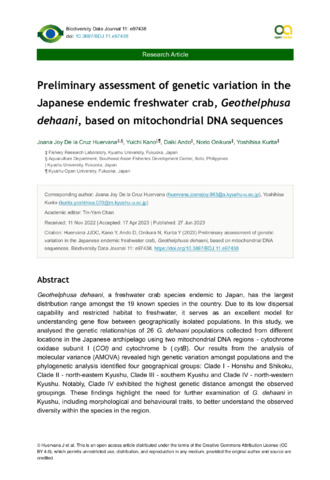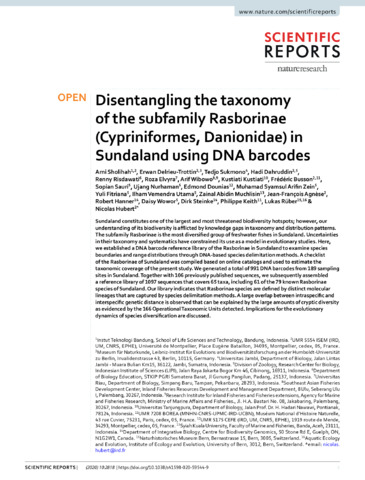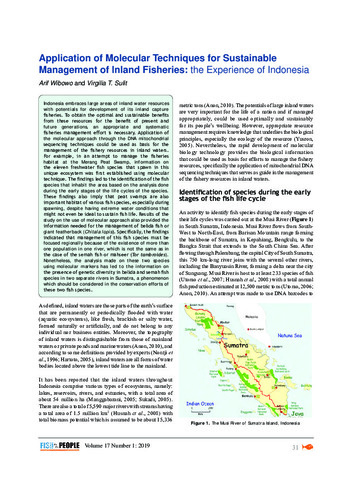| dc.contributor.author | Wibowo, Arif | |
| dc.contributor.author | Hubert, Nicolas | |
| dc.contributor.author | Dahruddin, Hadi | |
| dc.contributor.author | Steinke, Dirk | |
| dc.contributor.author | Suhaimi, Rezki Antoni | |
| dc.contributor.author | Samuel | |
| dc.contributor.author | Atminarso, Dwi | |
| dc.contributor.author | Anggraeni, Dian Pamularsih | |
| dc.contributor.author | Trismawanti, Ike | |
| dc.contributor.author | Baumgartner, Lee | |
| dc.contributor.author | Ning, Nathan | |
| dc.coverage.spatial | Sumatra | en |
| dc.coverage.spatial | Java | en |
| dc.date.accessioned | 2023-06-22T01:22:46Z | |
| dc.date.available | 2023-06-22T01:22:46Z | |
| dc.date.issued | 2021-04-29 | |
| dc.identifier.citation | Wibowo, A., Hubert, N., Dahruddin, H., Steinke, D., Suhaimi, R. A., Samuel, Atminarso, D., Anggraeni, D. P., Trismawanti, I., Baumgartner, L. J., & Ning, N. (2021). Assessing temporal patterns and species composition of glass eel (Anguila spp.) cohorts in Sumatra and Java using DNA barcodes. Diversity, 13(5), 193. | en |
| dc.identifier.uri | http://hdl.handle.net/20.500.14277/108 | |
| dc.description.abstract | Anguillid eels are widely acknowledged for their ecological and socio-economic value in many countries. Yet, knowledge regarding their biodiversity, distribution and abundance remains superficial—particularly in tropical countries such as Indonesia, where demand for anguillid eels is steadily increasing along with the threat imposed by river infrastructure developments. We investigated the diversity of anguillid eels on the western Indonesian islands of Sumatra and Java using automated molecular classification and genetic species delimitation methods to explore temporal patterns of glass eel cohorts entering inland waters. A total of 278 glass eels were collected from monthly samplings along the west coast of Sumatra and the south coast of Java between March 2017 and February 2018. An automated, DNA-based glass eel identification was performed using a DNA barcode reference library consisting of 64 newly generated DNA barcodes and 117 DNA barcodes retrieved from BOLD for all nine Anguilla species known to occur in Indonesia. Species delimitation methods converged in delineating eight Molecular Operational Taxonomic Units (MOTUs), with A. nebolusa and A. bengalensis being undistinguishable by DNA barcodes. A total of four MOTUs were detected within the glass eel samples, corresponding to Anguilla bicolor, A. interioris, A. marmorata, and A. nebulosa/A. bengalensis. Monthly captures indicated that glass eel recruitment peaks in June, during the onset of the dry season, and that A. bicolor is the most prevalent species. Comparing indices of mitochondrial genetic diversity between yellow/silver eels, originating from several sites across the species range distribution, and glass eels, collected in West Sumatra and Java, indicated a marked difference. Glass eels displayed a much lower diversity than yellow/silver eels. Implications for the management of glass eel fisheries and species conservation are discussed. | en |
| dc.description.sponsorship | We would like to thank the Research Institute for Inland Fisheries and extensions for their staffing. We also thank the officers from the local fisheries districts in South Bengkulu, Cilacap, Kebumen and Pacitan for assisting with sample collection and engaging in productive discussions. We wish to thank Siti Nuramaliati Prijono, Witjaksono, Mohammad Irham, Marlina Adriyani, Ruliyana Susanti, Hari Sutrisno and the late Sri Sulandari, at Research Centre for Biology (RCB-LIPI); Joel Le Bail and Nicolas Gascoin at the French embassy in Jakarta for their continuous support. We are thankful to Daisy Wowor and Ujang Nurhaman at RCB-LIPI, Sumanta and Bambang Dwisusilo at IRD Jakarta for their help during the field sampling. Finally, we acknowledge all the reviewers who helped with improving this manuscript. A permit to collect fish was awarded to Arif Wibowo from the Research Institute for Inland Fisheries and Extensions, Ministry of Marine and Fisheries Affairs, Republic of Indonesia and Nicolas Hubert (7/TKPIPA/FRP/SM/VII/2012, 68/EXT/SIP/FRP/SM/VIII/2013, 41/EXT/SIP/FRP/SM/VIII/2014, 361/SIP/FRP/E5/Dit.KI/IX/2015, 50/EXT/SIP/FRP/E5/Dit.KI/IX/2016, 45/EXT/SIP/FRP/E5/Dit.KI/VIII/2017, 392/SIP/FRP/E5/Dit.KI/XI/2018, and 200/E5/E5.4/SIP/2019). No experimentation was conducted on live specimens during this study. This publication has ISEM number 2021-084 SUD. | en |
| dc.language.iso | en | en |
| dc.publisher | MDPI | en |
| dc.relation.uri | https://www.mdpi.com/1424-2818/13/5/193/pdf?version=1620352163 | |
| dc.subject | eels | en |
| dc.title | Assessing temporal patterns and species composition of glass eel (Anguila spp.) cohorts in Sumatra and Java using DNA barcodes | en |
| dc.type | Article | en |
| dc.citation.volume | 13 | en |
| dc.citation.issue | 5 | en |
| dc.citation.spage | 193 | en |
| dc.citation.journalTitle | Diversity | en |
| dc.subject.asfa | DNA barcoding | en |
| dc.subject.asfa | genetic diversity (as resource) | en |
| dc.subject.asfa | DNA sequences | en |
| dc.subject.asfa | DNA | en |
| dc.subject.asfa | species diversity | en |
| dc.subject.asfa | mitochondrial DNA | en |
| dc.identifier.essn | 1424-2818 | |
| dc.identifier.doi | 10.3390/d13050193 | |
| dc.subject.scientificName | Anguilla | en |
| local.subject | species delimitation | en |
| local.subject | DNA-based classification | en |
| local.subject | genetic diversity | en |
| local.subject | catadromy | en |
| local.subject | conservation | en |



